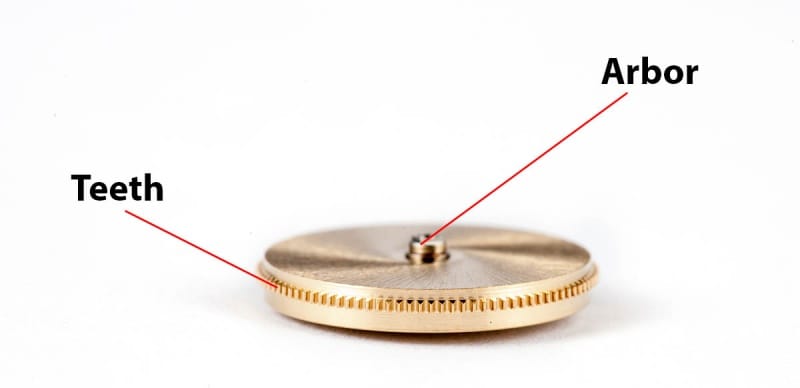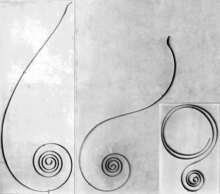In this article, we will delve deeper into the inner workings of a mechanical watch and focus on the crucial component responsible for storing the energy: the Mainspring. As we explained in our previous article, the energy enters the watch through either the Rotor or the Winding Crown.
Now, we will explore how the Mainspring mechanism stores and utilizes this energy. To help us visualize this complex system, we’ll start by taking a closer look at a typical mechanical watch model. Specifically, we’ll focus on the Mainspring. Its Click mechanism ensures the controlled release of energy.
If you’re curious about the basics of watch movements, we covered it extensively in our article The Magic of Time: A Beginner’s Journey into Mechanical Watch Movements.
Join us as we uncover the intricate details of this fascinating timekeeping device.

The Mainspring Barrel
The Mainspring, a vital component of a mechanical watch movement, is stored in a drum-shaped housing and is attached to the Arbor and the Barrel. The Arbor is responsible for transferring the energy from the Rotor or Winding Stem to the Mainspring. The Barrel is responsible for transferring the energy from the Mainspring to the Wheels.
The Going Barrel configuration, commonly used in modern watches, allows the Mainspring to power the watch while it is being wound. Turning the Arbor winds the Mainspring. This tightens the spring and wraps it around the Arbor. The Arbor has a ratchet attached to it, along with a Click that prevents the spring from turning the Arbor backward and unwinding.
After winding, the pull of the Mainspring turns the Barrel, which rotates once every 8 hours and drives the Wheel Train. This allows the Mainspring to power the watch movement while it is being wound. The Barrel has a ring of gear teeth that meshes with one of the clock’s gears, usually the Center Wheel Pinion, to drive the Wheel Train. The 40-hour spring usually requires 5 turns to unwind completely. We will discuss how this single rotation drives the wheels in the Train eight or 48 times faster in a later article.


The History of the Mainspring: From Weight-driven Clocks to Portable Timepieces
Mainsprings have been around since the 15th century when they were introduced as a replacement for the weight-driven mechanism used in previous mechanical clocks. The advent of mainsprings allowed clockmakers to create smaller and more portable timepieces, eventually leading to the development of the first pocket watches by the year 1600.
While some sources credit the Nuremberg clockmaker Peter Henlein with the invention of the mainspring around 1511, this is a common misconception. Early 15th-century evidence indicates the existence of spring-driven clocks, revealing the advanced horological technology of the time.
The first mainsprings were made of steel without any tempering or hardening processes. This resulted in limited power reserves that required the timepiece to be wound twice a day. Henlein was known for his watches that could run for 40 hours between windings, a significant improvement over earlier models.
The Going Barrel
The Going Barrel is a solution to the problem of inconsistent force provided by the Mainspring in spring-driven clocks and watches. The force of a Mainspring reduces as it unwinds. This affects the timekeeping accuracy of timepieces, as changes in the driving force influence their rate (see Graph 1).

Jean-Antoine Lépine invented the Going Barrel in 1760, which uses a longer Mainspring than necessary, coiled under tension in the barrel to produce a constant force. The tension creates a flat section in the torque curve of the spring, and only this flat section is used to operate the watch (see Graph 2). The outer end of the spring often has a reverse curve, forming an ‘S’ shape, which stores more tension in the outer turns of the spring. This makes it available towards the end of the running period.

As a result, the barrel provides almost constant torque over the watch’s designated running period, and the torque doesn’t decline until the Mainspring has almost run down.
Modern Mainsprings
Mainsprings have come a long way since their invention in the 15th century. Advancements in mainspring technology have enabled modern timepieces to keep accurate time over a longer period, making them more reliable and efficient than their predecessors.
Nowadays, a modern watch Mainspring is a long strip of hardened and blued steel or specialized steel alloy, measuring between 20 and 30 cm in length and 0.05-0.2 mm in thickness. The standard for hand-wound and self-winding watches is designed to run for 36 to 40 hours, with 24 hours between windings and a power reserve of 12 to 16 hours.
Since 1945, newer special alloys such as iron, nickel, and chromium, with the addition of cobalt, molybdenum, or beryllium, have replaced carbon steel alloys. Cold-rolled alloys known as “structural hardening” have also been introduced. These “white metal” springs are stainless and have a higher elastic limit. This makes them less prone to permanent bending or breaking. Some are also practically non-magnetic.
Modern mainsprings are made in three distinct shapes:
- Spiral coiled: These are coiled in the same direction throughout, in a simple spiral.
- Semi-reverse: The outer end of the spring is coiled in the reverse direction for less than one turn (less than 360°).
- Reverse (resilient): the outer end of the spring is coiled in the reverse direction for one or more turns (exceeding 360°).

The semi-reverse and reverse types provide extra force at the end of the running period when the spring is almost out of energy, enabling the timepiece to run at a constant rate until the end.
Conclusion
In addition to the advancements in mainspring technology, the development of quartz and atomic timekeeping has further revolutionized the watch industry, providing even greater accuracy. However, despite these technological advancements, the art of watchmaking remains a delicate and precise craft, and the intricate workings of a mechanical watch continue to captivate and inspire watch enthusiasts around the world. As we continue to push the limits of precision in timekeeping, it is exciting to see what new developments will emerge in the future.

I still don’t understand where the spring goes as it runs out. I have a skeleton mechanical watch and I’ve let the watch wind down and stop but where did it go? I can’t see that.
LikeLike